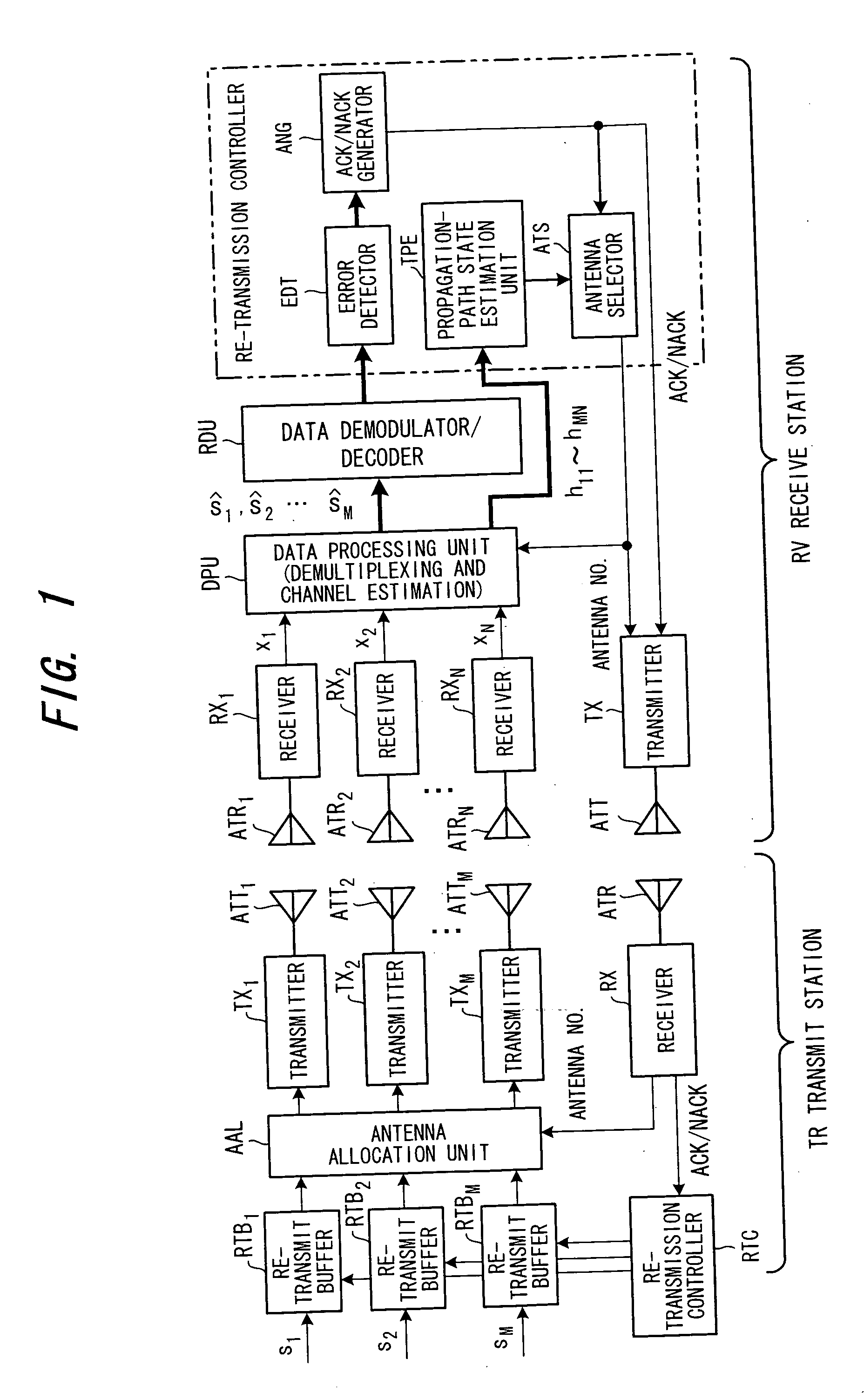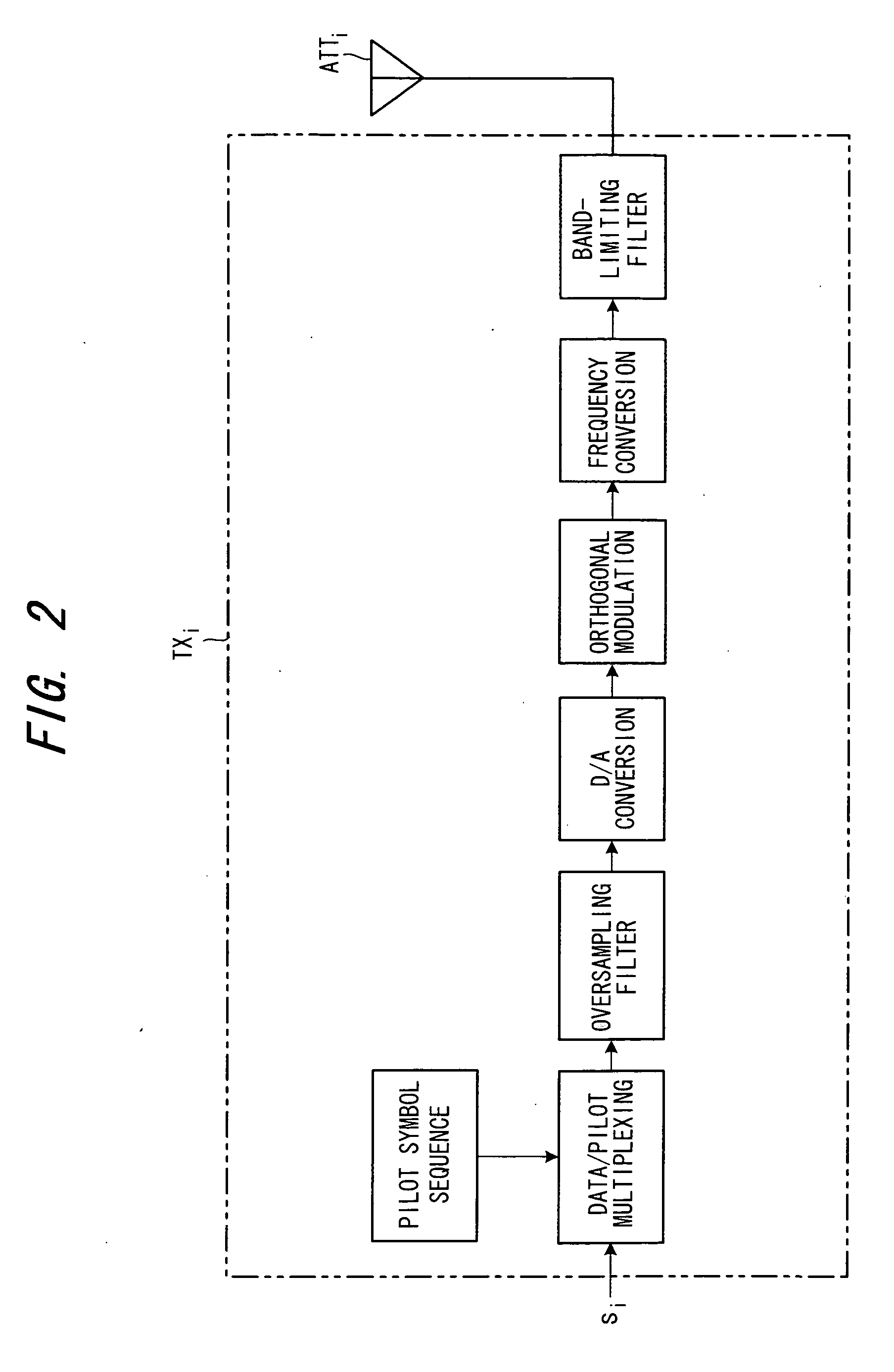Multiple-input multiple-output transmission system
a transmission system and multi-input technology, applied in the direction of orthogonal multiplex, channel coding adaptation, site diversity, etc., can solve the problems of increasing the cost of transmission equipment, so as to increase the re-transmission efficiency
- Summary
- Abstract
- Description
- Claims
- Application Information
AI Technical Summary
Benefits of technology
Problems solved by technology
Method used
Image
Examples
first embodiment
Operation of First Embodiment
[0046] In the receive station RV, the data processing unit DPU estimates the channels h11 to hMN using pilot symbols and executes MIMO channel demultiplexing processing. When channel estimation is performed, the data processing unit DPU demodulates the pilot symbol and compares the phase and amplitude of the demodulated pilot symbol with the phase and amplitude of an already known pilot symbol to thereby estimate the characteristic A·exp(jφ) of the channels h11 to hMN. Since the pilot symbols transmitted from each of the transmit antennas are orthogonal, the data processing unit DPU is capable of estimating the channels h11 to hMN.
[0047] Further, when channel demultiplexing in a MIMO system is performed, the data processing unit DPU uses a method such as ZF, MMSE, BLAST or MLD mentioned above. The error detector EDT performs error detection for every demultiplexed data stream ŝ1, ŝ2, . . . ŝM by a method such as CRC check, and the ACK / NACK generator ANG...
second embodiment
Operation of Second Embodiment
[0062] In the receive station RV, the data processing unit DPU estimates the channels h11 to hMN using pilot symbols and executes MIMO channel demultiplexing processing (data-stream demultiplexing processing) in a manner similar to that of the first embodiment. The error detector EDT performs error detection for every demultiplexed data stream ŝ1, ŝ2, . . . ŝM by a method such as CRC check, and the ACK / NACK generator ANG reports the result (ACK / NACK) of error detection on a per-data-stream basis to the transmit station by the control channel using the oppositely directed radio link (transmitter TX, transmit antenna ATT, receive antenna ATR, receiver RX). The propagation-path estimation unit TPE estimates the state (reception power S or SIR) of the propagation path of every transmit antenna using the channel estimation results h11 to hMN and, together with the ACK / NACK information, reports this to the transmit station by the control channel using the opp...
third embodiment
(C) Third Embodiment
[0066]FIG. 7 is a diagram illustrating the structure of a receiver according to a third embodiment. This embodiment differs from the second embodiment in that a re-transmission combiner RTC is provided. It should be noted that although the transmit station is not illustrated, it has a structure identical with that of the second embodiment.
[0067] In order to improve the reception quality of the re-transmission signal, the re-transmission combiner RTC combines the re-transmission packet and a packet transmitted previously and for which NACK was detected. That is, an error-containing packet for which reception has failed and a re-transmission request (NACK information) been issued is stored in a re-transmission combining buffer by the re-transmission combiner RTCB. When a packet (data stream) that has been re-transmitted is received, the re-transmission combiner RTCB combines the re-transmission packet and the packet (data stream) inside the buffer. By thus combini...
PUM
 Login to View More
Login to View More Abstract
Description
Claims
Application Information
 Login to View More
Login to View More - R&D
- Intellectual Property
- Life Sciences
- Materials
- Tech Scout
- Unparalleled Data Quality
- Higher Quality Content
- 60% Fewer Hallucinations
Browse by: Latest US Patents, China's latest patents, Technical Efficacy Thesaurus, Application Domain, Technology Topic, Popular Technical Reports.
© 2025 PatSnap. All rights reserved.Legal|Privacy policy|Modern Slavery Act Transparency Statement|Sitemap|About US| Contact US: help@patsnap.com



